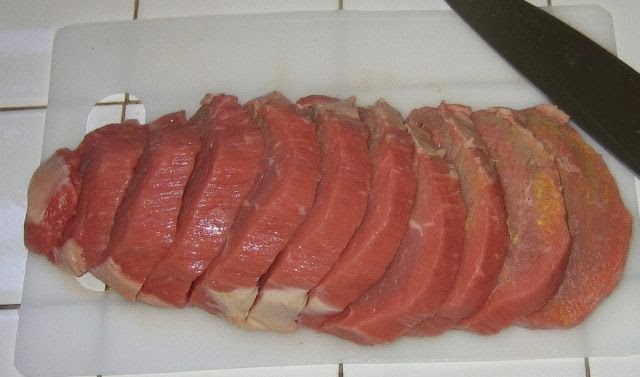The sale of our cow was initiated by word of mouth. A friend of my wife, who knew we were interested in buying a cow, knew a rancher hobby-ist who we ultimately bought the cow from. We were excited and nervous, this being our first time purchasing a cow, and the seller hadn’t taken the private sale route before either. Neither one of us wanted to be taken for a ride. A price per pound was offered. Then the next day, the seller changed her mind; she wanted a flat rate to be paid.
Ranchers strive to harvest their beef when the animal is somewhere around 1250 lbs. That is, perhaps, why livestock are brought to feedlots, so through careful control that weight can be obtained and in an expeditious fashion. Our cow was probably around 750 lbs; it was 536 lbs hanging weight after euthanasia -- not nearly as large as we were hoping for, but we don’t consume a lot of beef anyway. Our goal is to have a years worth of beef in our freezer.
 Once we settled on a price, we contacted a meat service company (a butcher) to handle the euthanasia and the cuts of beef. After a date was scheduled for euthanasia, we were directed to think about the cuts of meat that we wanted and to call back when we were ready. After a quick search online, we found this helpful diagram. I think I’ve also seen something similar in some fancy cookbooks.
Once we settled on a price, we contacted a meat service company (a butcher) to handle the euthanasia and the cuts of beef. After a date was scheduled for euthanasia, we were directed to think about the cuts of meat that we wanted and to call back when we were ready. After a quick search online, we found this helpful diagram. I think I’ve also seen something similar in some fancy cookbooks.We knew we wanted hamburger meat as it is used is many of our recipes. It should come as no surprise that hamburger is typically ground from what you have after all the desirable cuts have been made. The fillet mignon, tri-tip, sirloin, porterhouse, and t-bone all come from the “short loin” and “sirloin” sections of the carcass -- that’s the good stuff. The “round” and “chuck” are typically used for those meat-and-potatoes roasts you cook in a crockpot.
That leads to another point. We soon realized as we were writing down the various cuts we desired that we couldn’t have it all.
1 roast == multiple steaks

That little fact, perhaps, is very clear to most, but it was new to us. So we crossed “tri-tip roast” off our list and kept the “tri-tip steaks”. Our cow is small (labeled a runt by the rancher), so these turned out to be small “tri-tip” steaks. We both enjoy cooking a roast once a month, so we asked for as many of those as we could. We included “flank steak” on the list for our stir fry dishes. Reviewing the chart has transformed how I view the cuts of meat at the store. In a macabre way, it’s kind of like putting a face with a name. Now I understand why there are only 2 “tri-tip” roasts per carcass and only 1 “flank” steak. A little anatomy lesson goes a long way!
 When we called the meat service back again to place our cut order, the lady we spoke with was friendly and understanding that we were new to all of this. We started providing a list of what we wanted and ended up explaining what we wanted to use the meat for and letting the representative complete our order.
When we called the meat service back again to place our cut order, the lady we spoke with was friendly and understanding that we were new to all of this. We started providing a list of what we wanted and ended up explaining what we wanted to use the meat for and letting the representative complete our order.
It didn’t take long for the cuts to be made and soon my wife picked up the meat, each cut wrapped in freezer paper and labeled. The hamburger was packaged in 1 lb sausage packages. As I look in the freezer, I am again reminded of the meat section in the grocery store. We now know where the various meat cuts come from instead of thinking that meat is..., well, meat.
Here is a break down of the cuts we ordered:



No comments:
Post a Comment